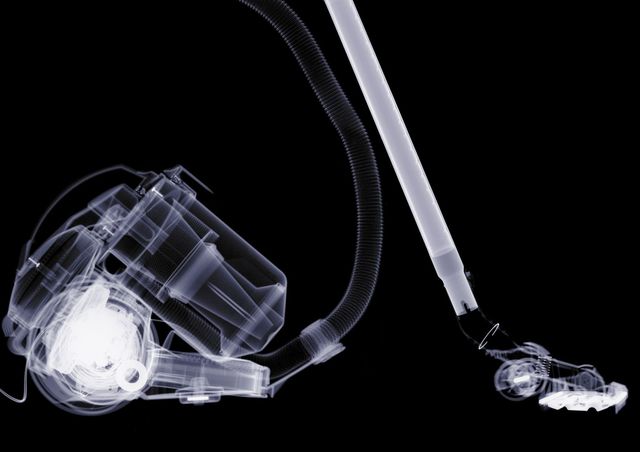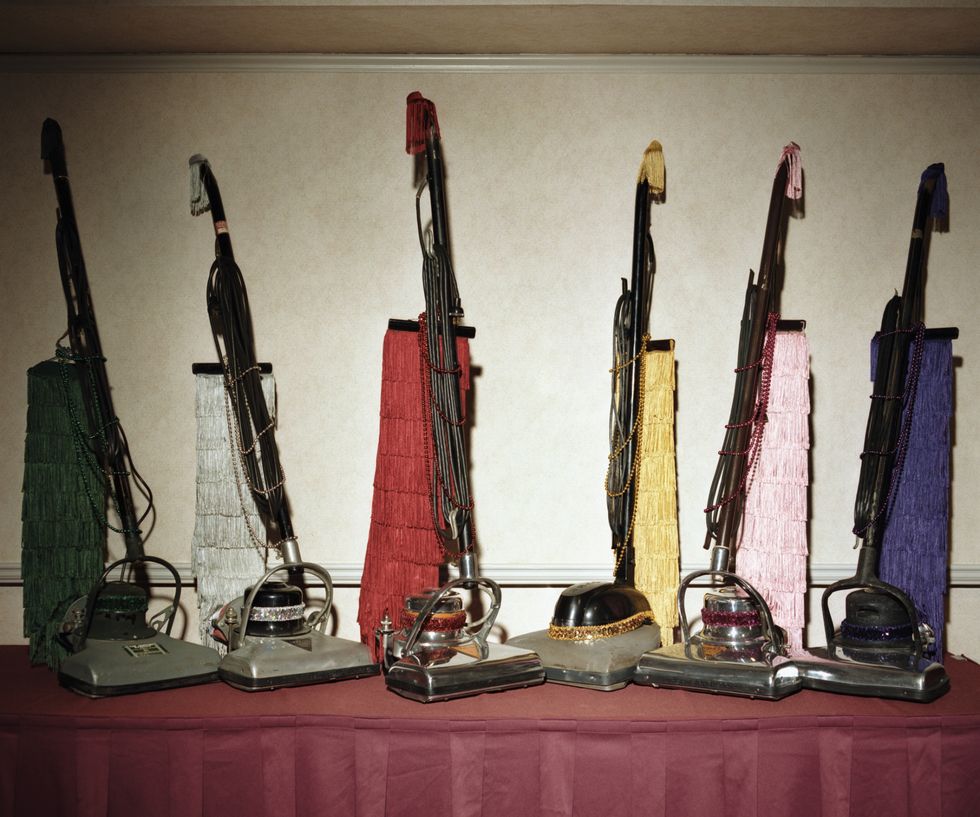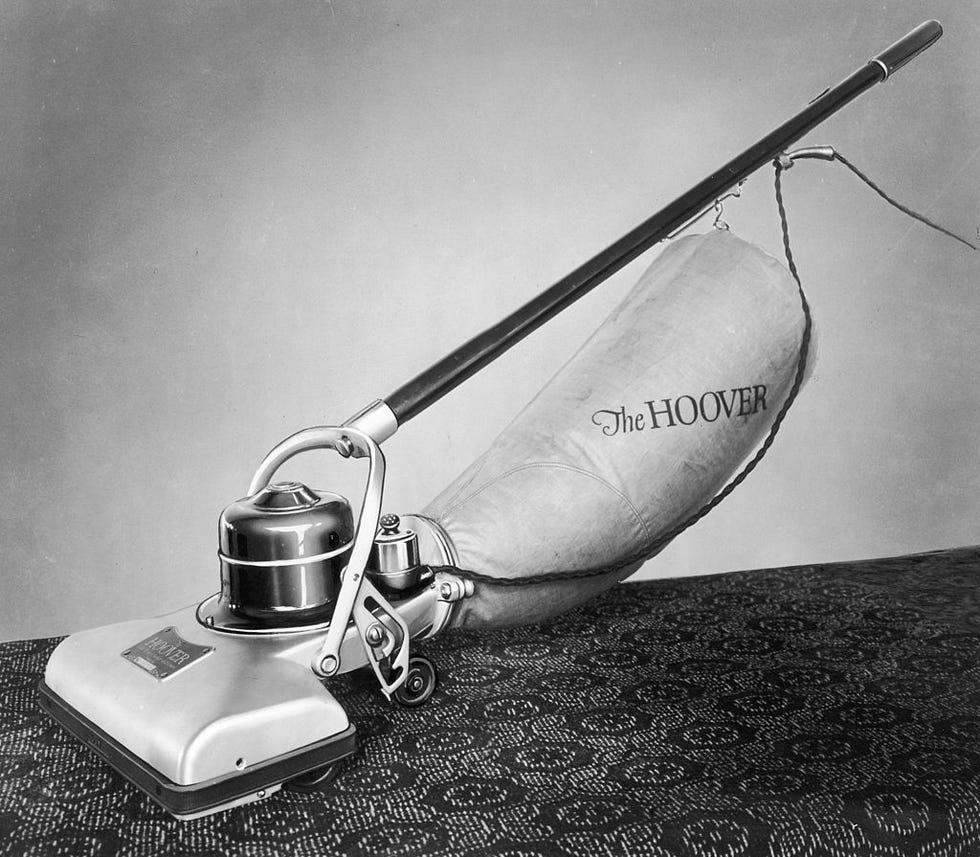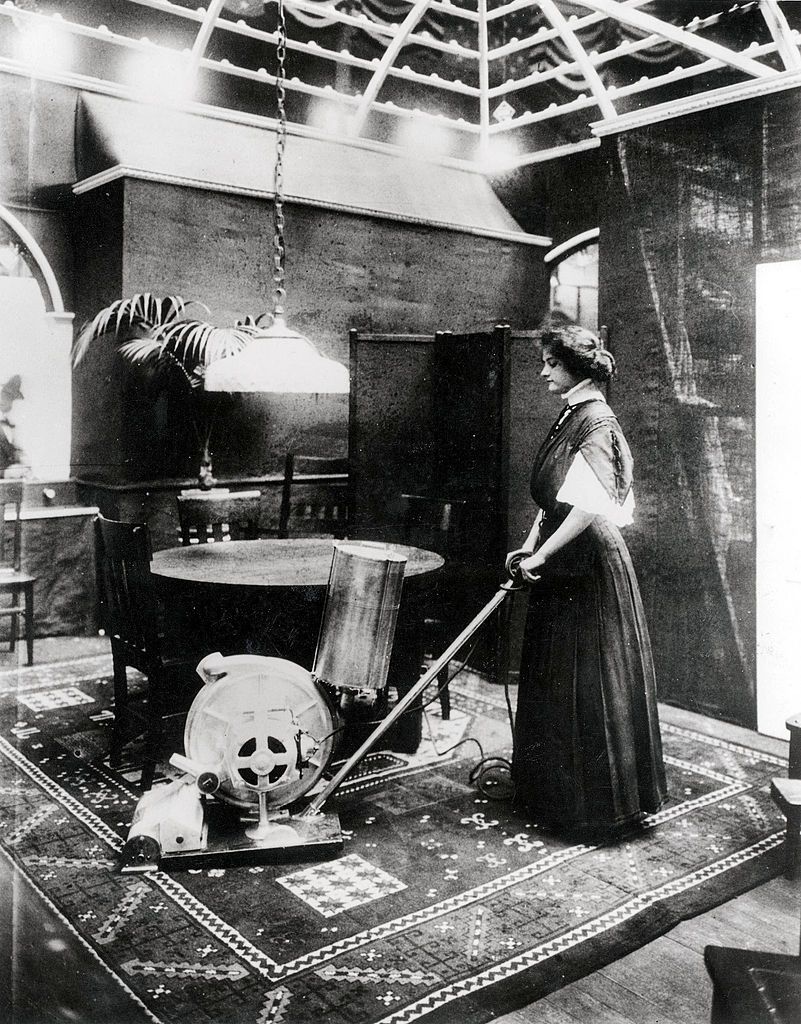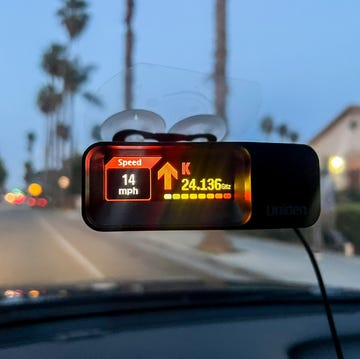If cleanliness really is next to godliness, then a vacuum cleaner is a religious necessity. This noisy, awkwardly-shaped contraption performs the mundane task of sucking up grime with precision and efficiency. While vacuum cleaners today are a multi-billion dollar business a household necessity, you might be surprised to learn the machine's basic design and performance hasn't changed much in the last hundred years.
"A vacuum cleaner from 1910 would clean the rug just as well as a modern vacuum cleaner from today," says Tom Gasko, one of America's foremost vacuum cleaner historians and the curator at the Vacuum Cleaner Museum at Tacony Manufacturing in St. James, Missouri. Here's the dirty history of this household cleaning machine, from crude carpet cleaners to horse-drawn carriages to Hoover.
The Dawn of Suck
It starts with the broom. While archaeologists have found rudimentary examples of the cleaning tool dating back to 2,300 B.C., the broom wasn't perfected until 1797, when Massachusetts farmer Levi Dickenson noticed his wife struggling with hers. It didn't sweep well and the bristles kept falling out. So Dickenson put together a broom made out of a variety of sorghum, a grain that grows tall like corn and is used as livestock feed. Sorghum—which is stiff, strong, and didn't fall apart—proved to be perfect for a broom. Dickenson made a few dozen more brooms, selling them to neighbors. Within three years, the farmer and his sons (along with servants) were making and selling hundreds of brooms across New England. By 1850, sorghum brooms had earned the grain a new name: broomcorn.
It wasn't long before people were seeking a better, less tedious, and more technologically advanced way of cleaning. In England, ambitious inventors earned patents for mechanical sweepers that cleaned streets, floors, and carpets. Their inner working were simple—a manual system of pulleys and cranks that rotated a brush or sweeping apparatus to push dirt into a receptacle. Yet these complex devices were not much better than a broom. In 1858, Hiram Herrick of Boston submitted what was probably the first American patent for a "carpet sweeper" (though, it was essentially a copy of a British patent). Basically, it was a rolling broom and dustpan. Over the next two years, various inventors submitted patents that made vague improvements on this design. Few were actually produced and even fewer were ever sold.
Then came Daniel Hess. With the country on the brink of Civil War, the Iowan inventor changed the carpet-sweeping game with one simple addition: air. Hess's 1860 patent describes his innovation: "The nature of my invention consists in drawing fine dust and dirt through the machine by means of a draft of air." Hess's machine was still manually operated; you needed a bellows to create suction and draw in the dirt, which limited its ability to really do much of anything (no wonder historians say Hess probably never built the machine). But this 1860s device was the first rudimentary design for what we now call a vacuum cleaner.
Taking the concept a step further in 1869, Ives McGaffey of Chicago used a fan to move the air and stood his machine upright. He was also a much better marketer than Hess, writing in the patent: "The accumulation of dust and dirt/in dwelling-houses is a source of great annoyance to all good housekeepers... to obviate these difficulties is the object of my invention." Despite his grand intentions, McGaffey's "Whirlwind" was not a success. With a retail price of 25 dollars (about $450 today) and a hand crank, the Whirlwind was considerably harder to use than a simple broom. The Whirlwind nearly drove the company that produced it out of business, and thanks to slow sales and two factory fires, nearly all Whirlwinds had been destroyed by 1872.
More Power
The trouble for Hess and McGaffey was that moving air is only half of the solution. Vacuuming maybe be a boring chore, but it's a pretty easy one because electrical power does all the hard suction work. Nobody wants to crank up their Dyson or Hoover.
By the late 19th century, new innovations made this dream possible. Gasoline, for instance, emerged as a source of fuel in 1892. In 1898, John S. Thurman of St. Louis created his gasoline-powered "pneumatic carpet renovator." While technically not a vacuum because it didn't suck, the machine produced an "air-blast" to dislodge the dust and blow it into a receptacle. The device was the size of a horse-drawn carriage. Thank goodness Thurman made house calls. The inventor took out ads in the St. Louis Dispatch and charged four dollars per visit ($110-115 today), creating a moderately successful business.
Various people tried to improve on Thurman's patent with limited success. One story goes that an unnamed inventor in London was at a trade show, boasting that his particular gas-powered carpet cleaner was the latest and greatest, when he was approached by the English structural engineer Hubert Cecil Booth. According to a 1935 article Booth wrote about this incident many years after the fact, the inventor was apoplectic when Booth questioned him as to why the machine didn't suck in dust rather than expel it. "He became heated, remarking that sucking out dust was impossible," Booth would write.
Booth knew better. An accomplished engineer for the British Royal Navy, he essentially reverse engineered Thurman's patent and came up with the "Puffing Billy." Big, red, and gasoline-powered, it paraded through London's streets pulled by a horse-drawn carriage. The contraption became a common sight around town, its pipes snaking from Booth's machine into big buildings. The Puffing Billy secured high-profile jobs. According to The Atlantic, in 1902 Booth was commissioned to clean Westminster Abbey for the coronation of King Edward VII and Queen Alexandra. The royal couple were so impressed that they purchased Booth machines for Buckingham Palace and Windsor Castle. During World War I, a fleet of "Puffing Billys" were employed to clean London's Crystal Palace after naval reservists came down with spotted fever.
By the turn of the century, Booth's device wasn't just riding around on the streets. It was being built right into the homes of the wealthy, creating the central vacuum. "They were being put into buildings, hotels, beautiful high-rises in New York... essentially Booth's vacuum installed in one room of the building," says Gasko. "They became very popular for people with large homes, but not for those with a regular home."
That was exactly the problem. Due to expense and size, vacuums were limited to the upper crust of society. In 1907, an Ohio janitor changed that.
Hoovering On Up
It isn't correct to say that James Murray Spangler invented the vacuum, but he certainly revolutionized it. A 60-year-old department store janitor in Canton, Ohio, Spangler's cleaned the entire building each night, a task that was not only long and tedious but also took its toll on his asthma. A tinkerer and inventor, he devised his own Frankenstein contraption using a broom, a pillowcase, and an electric motor. What made Spangler's machine different, Gask says, was that it was upright and portable. "It used a ceiling fan motor and paddle blades to create the air flow... he used a leather belt and journaled it to a rotating brush that he had gotten out of a carpet sweeper... No one was able to get the carpet that clean because they didn't have a motor driven brush."
The crude machine worked well, sucking dirt and blowing it out the back into the attached pillowcase. Spangler patented it in 1907 and quit his job, opening the Electric Suction Sweeper Company. Investors (including the department store owners) helped him to begin production on his invention. It wasn't enough. After buying 75 motors and obtaining factory space, Spangler was so strapped for cash that he used his house as collateral. Says Gasko, "Not only had he defaulted—they were actually coming to take his home away from him, lock the doors of his house and put it up for auction." In financial distress, Spangler turned to one of his early satisfied customers: his cousin, Susan Hoover.
Susan Hoover's husband was William Hoover, who was already a well-known leather goods manufacturer. Despite initial misgivings, Hoover purchased the patent from Spangler in 1908. Pouring money into marketing, research and development, and door-to-door salesmen, Hoover was the one who turned Spangler's invention into a business success. Carroll Gantz, author of The Vacuum Cleaner: A History, said in an interview with Ozy, "Without Hoover, [Spangler's] business would have failed."
More than a century later, everyone knows the name Hoover. The company does millions in sales. (At some point people even called the action of vacuuming "hoovering.") However, the in-home vacuum cleaner hasn't changed a lot since Spangler's prototype. Sure, they are sleeker, quieter, and smaller. But "go back to the... 1930s, nothing new has been invented since that time," Gasko says. "It really hasn't."
If anything, vacuum cleaners have decreased in quality, with motors wearing out quicker and dust clogging the modern circuit boards. "Vacuum cleaner motors from the 1910s drew about 1.5 amps and rotated between 1000 to 3000 rpm," Gasko says. "By the time we got to the 1930s... a lot of those motors were now drawing 3 amps and turning 5 to 6000 rpms, but were wearing out eight times faster.... The faster it turns, the faster it (wears out.)" Today, a state-of-art Hoover draws 11 amps and a new Dyson rotates at 104,000 rpm. "It is not really that it has more suction or has more power," says Gasko. It simply runs faster.
In the years since Hoover acquired Spangler's patents, there have been a few helpful improvements that have bettered the vacuuming experience. They've gotten cleaner, thanks to the introduction of less porous cloth bags in the 1930s and the modern-day HEPA filters and bags. Vacuums have gotten smaller and more portable, culminating in Black and Decker's 1975 cordless vacuum patent and the 1978 introduction of the Dustbuster. They've become more stylish and cooler, with Dyson's 1991 "G-Force", a $2,000 status symbol of a cleaning device. Then, of course, there was Roomba, making its creeping debut in 2002 and taking vacuuming into the robotics age.
Even with all these innovations, though, a vacuum of today still does the job about as well as it's done for more than a century. It still sucks.
Matt is a history, science, and travel writer who is always searching for the mysterious and hidden. He's written for Smithsonian Magazine, Washingtonian, Atlas Obscura, and Arlington Magazine. He calls Washington D.C. home and probably tells way too many cat jokes.
